There are a lot of rifle competitions these days, but one special organization hosts rifle events with a purpose. Guardian Long Range matches are run by a non-profit organization that raises funds and awareness for the benefit of foster and orphan programs in the community around their events. Since their inception, Guardian events have been designed to be fun and a little different than other matches, bringing people together to shoot and support a great cause. While they are competitive, there are no points to chase, extensive rules to abide by and the big checks go to those really in need. If someone is struggling on the clock, they can get a little help. Should attitudes start to creep in, reminders are made that these are meant to be fun matches. All of the prizes are handed out via a fundraising raffle, with match winners only taking home bragging rights and a trophy. Gary and the team at Guardian are driven with a purpose and have found their niche. (Read more about the Guardian story here).
The more traditional Guardian matches are one-day singles events, but then pair up shooters by placement to shoot a team version the next day. A couple years ago they started to offer two-day team matches that ratcheted up the intensity compared to their regular events. My partner and I missed out on the first full team match in 2019, but made it a point to attend the 2020 match after hearing rave reviews. We had a lot of fun in 2020 and decided to head back to Barnwell, SC and the Government Training Institute facility for the 2021 GTI iteration of the Guardian Team Match.
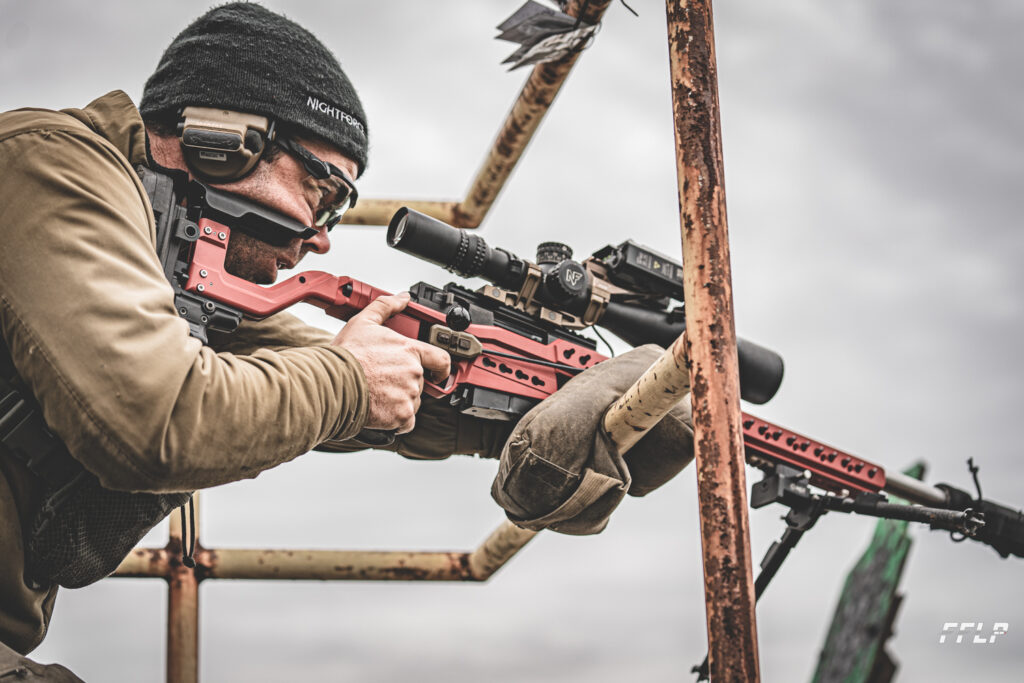
Special thanks to Daniel of Two Vets Tripods/First Focal Length Photography for the excellent action photos. Also to Dexterity Media for some others from the event.
Pre-Match
In years past Guardian team matches have included primary and secondary shooter roles, with the latter needing to shoot a .223 or .308 chambered rifle. With the ammo/component shortages, that was suspended so that both shooters could run whatever rifle they could get ammo for. Because of this, we decided to run identical rifles/ammunition for simpler logistics and hopefully some advantages on stages. At team matches, it’s not uncommon to shoot your partner’s rifle or manage a lot of information in a limited amount of time, so any commonality can help.
Earlier this year, Accuracy International released their AT-X rifle, which we both pre-ordered. Given the timeline of release, we both hoped that we could get the rifles in time for some fall team shooting. The rifles eventually got to us, with Greg’s making it to us the Thursday before the match (BIG shout-out to the excellent folks at Mile High Shooting for helping us with the rifle purchases). Normally we wouldn’t take a brand-new rifle to a match like this, but let me explain how it worked out…
Pre-Fit Performance
While we got the second AT-X just in the nick of time, we did have a plan in place to make it work. One of the great advantages to an AI is the ability to easily change barrels without having a gunsmith fit every barrel to each specific gun. By holding specific tolerances in making actions and barrels, the barrels can be “pre-fit” to the rifles. And since AI has held the same specs for the last 30-40 years, rifle models like the AT-X today can share barrels with older AX and AWs. Between my AT-X arriving first as well as my older AX on hand, our matching Proof Research Comp Contour 6mm Creedmoor barrels ended up at my house for brake in and load development. With the consistency of the barrel work, I was easily able to work up a single load of Hornady 110gr A-Tips and Hodgdon H4350 for both barrels.
With the barrels and ammo ready, we just needed the rifle to show up to finish setup. The Thursday before, Greg got his rifle and set it up late at night in my garage. The Friday before the match we quickly zeroed the AT-X and worked out to about 800 yards at a private range. The ammo performed exactly as it should, with both rifles being within 5 feet-per-second on muzzle velocity and displaying excellent accuracy. After verifying our drop data at distance, it was off to some dinner with friends before the evening brief and prepping our gear for the match.
Day 1
The first morning had a muster of 7:30am before everyone walked over to view a car being blown up with Tannerite. One lucky raffle winner had the honors of administering a healthy 75lb dose to a Ford Taurus.
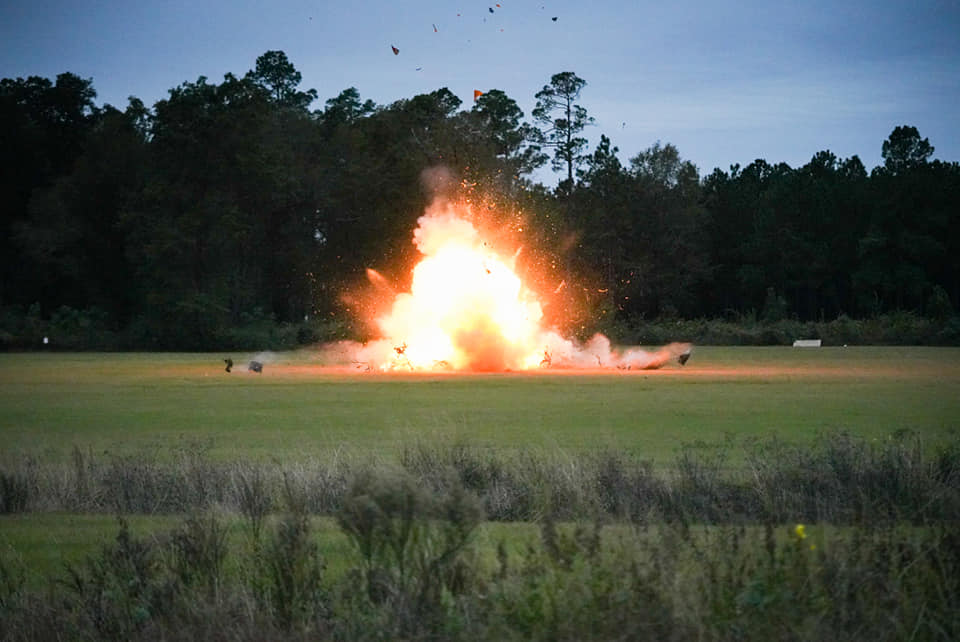
Utilizing lessons learned from prior years, the match was broken down into two areas of six stages. Our first set of stages took place in the large tower at GTI, getting up to 9 stories above ground. We were on squad 11, thus started on stage 11. I’ll explain each stage in the order that we shot them.
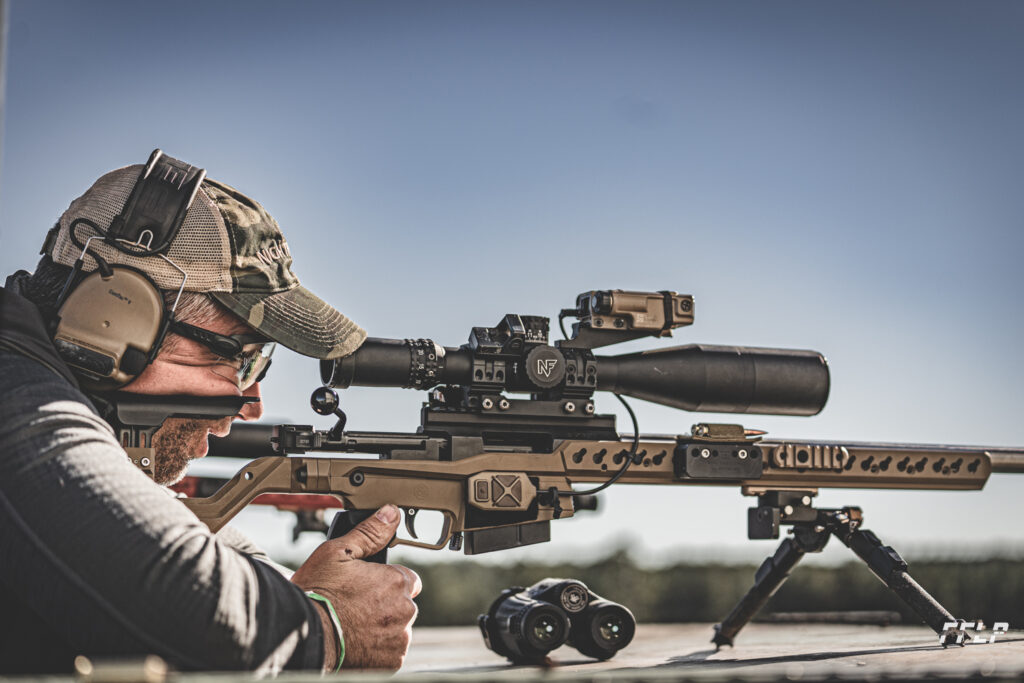
Stage 11 – Long & Short
Our first stage was called Long & Short. In this the first shooter engaged an array of three targets from about 200 to 450 yards, engaging with two shots per target. Then the second shooter engaged an array of plates from 800 to about 1000 yards, with two shots each. After this was done the shooters swapped rifles and target arrays. The long-range targets were worth twice as many points, meaning you should really hit them.
My first array was shot clean, having to hold a little bit of wind at the 450 yard plate. Greg hammered the long-range targets, getting most of his shots as hits. Then he swapped straight to my rifle, but because of where the rifles were we couldn’t both lay down like we planned. With that minor change, I pointed out targets, dialed the drop data and gave wind calls for his shots, ensuring 6 out of 6 hits. Time started to get short at this point, so I jumped onto the other rifle and got a couple /hits rushing through the targets. Our final score ended up being 22, tying for second place on the stage.
Stage 12 – Symbol Psychosis
Like any good sniper themed match, there is going to be some element of target identification and memorization games. However since the Guardian is meant to be fun, if you paid attention to your emails there was a provided sequence of random symbols. At this stage, either the red or black symbols were identified as your target package. Then, shooters had to move around the building to find and engage the targets with three rounds per shooter, with each shooter engaging the identified target before moving to the next target..
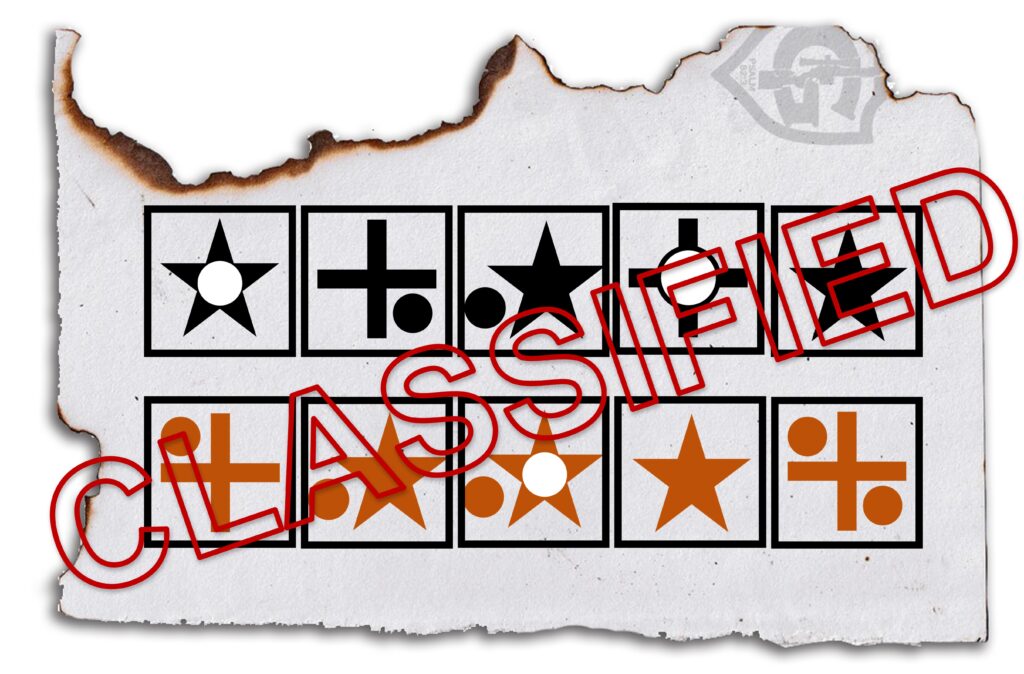
Since we had the intel, we quickly verified the sequence and moved to establish our position. The engagement box was about 6 stories up, with the targets being as close as 150 or so yards away…meaning there was a fair amount of down-angle to the shots. We got into prone, being able to get our Ckye-Pod bipods low enough to use bags on the rear. From here I used my binoculars to start finding and identifying what we needed to shoot. Instead of trying to find them all before shooting, we hunted out one target at a time since we both had to engage it before moving on. Also, all of the targets had a second “hostage” target worth negative points, meaning careful aiming was required.
Our shooting here went well as we found the targets and worked our way through them with relative ease, finishing in about four minutes. I dropped one shot at a close but higher angle target, just whiffing the shot. This ended up being good for 29 of the 30 possible points.
Stage 7 – Hangers and Hiders
This stage started with pistols out, with each shooter allowed three attempts for score on a close range pistol shot. After that was done, it was time to go to rifles out of two windows. Any position could be assumed, with the caveat that both shooters couldn’t do the same position (ie both prone). We chose for me to go prone and then Greg used a GameChanger off of a cross-support in a window. Also, this was all done with your partner’s gun (which wasn’t a big deal since we ran near clones of each other).
The target array was a set of yellow circles and diamonds along the tree line, with a fairly wide pan. Each target was engaged twice per team member before changing targets. I missed my first shot for not enough wind, but then had good hits after that. I did cost us a point from panning too far and engaging the wrong target with a round. From Greg’s position it was a little more shaky, but we ended up with a score of 19 (with the best runs being at 20).
Stage 8 – Forest Foray
Forest Foray was one of the harder stages for the match. A series of randomly numbered placards was placed in the treeline, with hidden targets somewhere close to the placard. The catch was there were eight placards but only five targets. Once a target was identified, each shooter engaged the target with three attempts for score. Should a team make it all the way through, some tannerite was placed for a bonus target.
For our run I started us on a target fairly quickly, but it was hard to see clearly so we dropped a shot or two figuring out where to hold. Next, I found another target that we could only see a part of due to vegetation, but we were also able to get some hits on it. Greg found the next target, where we managed a few more hits into some vague square in the shadows. Then we spent a fair amount of time trying to find the other two targets. Ultimately Greg found one and I found the other, but the placard for Greg’s was blown down with the wind so we both thought we were engaging the same target. I got my hits and then Greg picked up another point as time expired, getting us to 14 hits. In all, this one was a stage to survive as it was one of the lower scoring stages of the match.
Stage 9 – Ladder Building
We got our asses kicked on the first run of this stage. One of the great things about a charity match is some of the extra perks, like paying $50 for a mulligan that can be used on any one stage. After our train-wreck, we came back around and cleaned the stage.
In short, the shooters were presented with a required shooting area and could use anything in the room or what they brought. The shooting box was well inset into the building, essentially requiring some kind of position building to see the targets. As for target engagement, both shooters had to hit each target in order to advance to the next. If either missed, they had to restart on the previous target, moving forwards and backwards this way. The point values for hitting the targets increased in value (1, 3, 5, 7 and 9 pts) due to the greater difficulty in reaching them. Whenever the shooters decided to call it quits or finished the rifle targets, three pistol head plates were located about 6-7 stories straight down that could be engaged for three points per shooter.
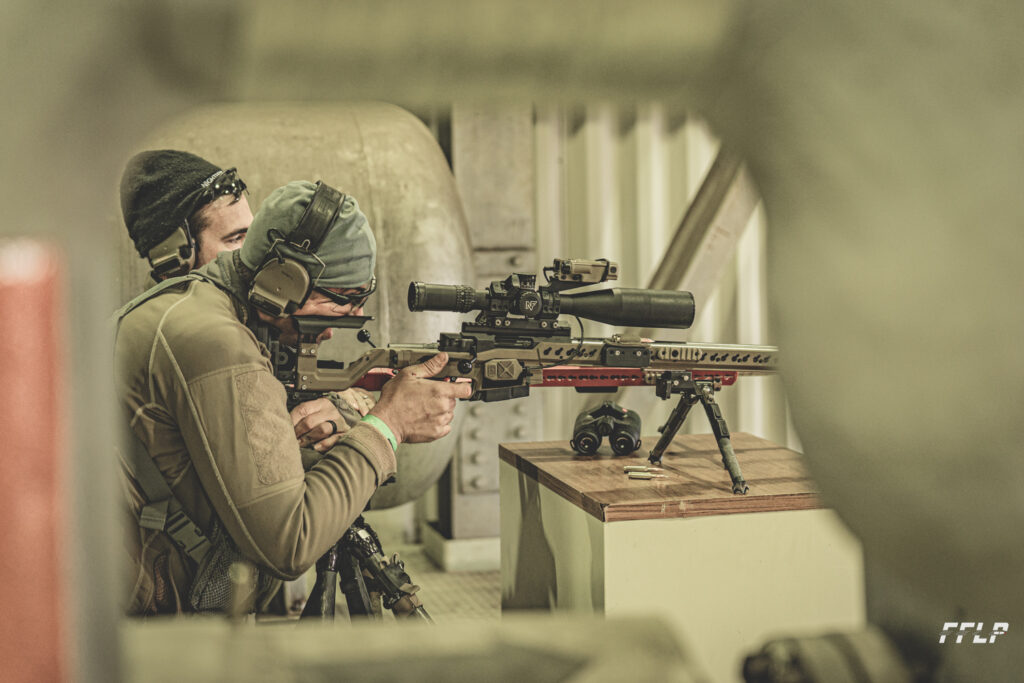
For our first run we dragged a small desk over, then tried to use tripods for rear-support. With the narrow shooting position, we had to trade off with someone on the gun and generally just didn’t take good shots. I struggled to get rounds on steel, requiring us to keep moving back and forth between the first two targets. Because of the amount of time we wasted, we just couldn’t get enough rounds fired to work through our problems. Choosing to use our mulligan, we reused the desk, but keep it simple and let the guns rest on our GameChanger bags. This worked like a charm, and while we had to fire a few extra rounds due to some misses in the wind, we got all of the rifle plates and the pistol plates with plenty of time to spare. In this instance, our mulligan run took us from a miserable seven points to cleaning it at 31 points.
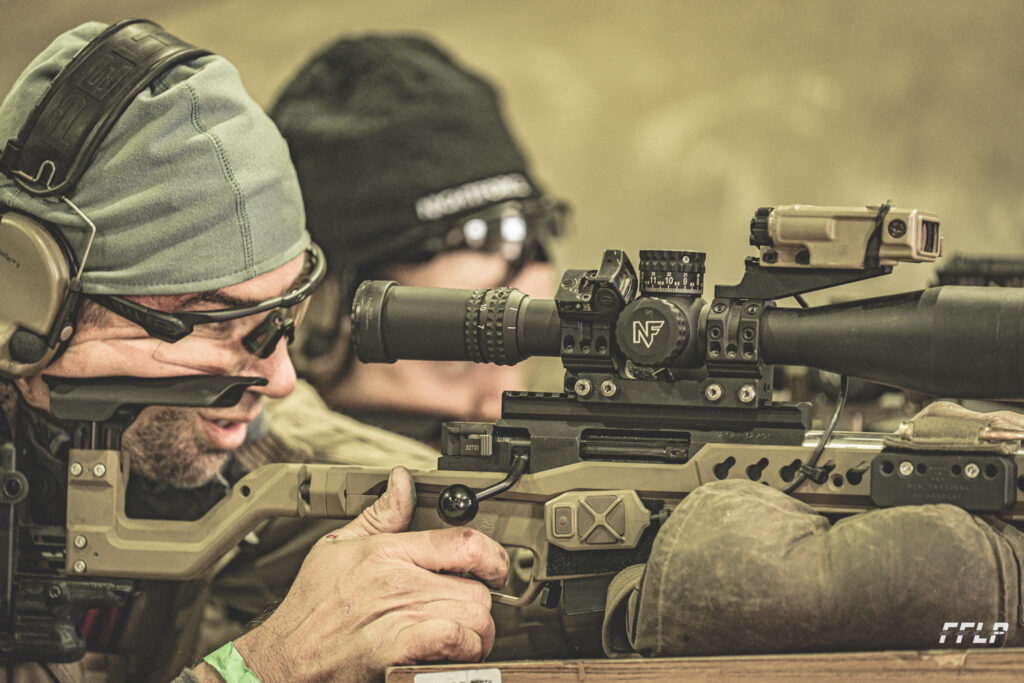
Stage 10 – Junkyard Music
Our last stage of day one was the infamous music stage (similar to other notorious versions in previous years). To start, a pistol plate was located outside of the starting doorway and each shooter had four attempts for score. The premise for engaging rifle targets was simple, each shooter had the other’s target engagement sequence. The shooters would call out each others targets, which then had to be located and then engaged twice. To keep it interesting, this had to be done while a loud speaker played a loop of some pretty awful noise during the stage.
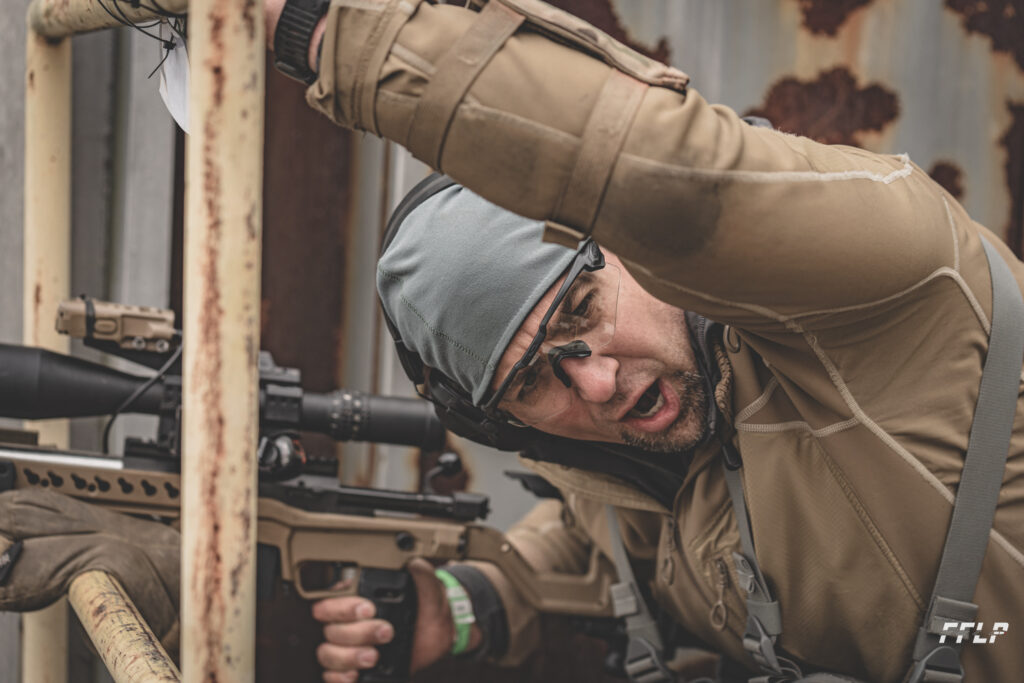
Shooting the pistol was an easy eight points before getting to the rifles. Then it was time to shout and play hide and seek with the targets. We worked out to share each others target identifier and then each engage before trying to share any more info. Once my first target was found, I hit it with my Wilcox Raptar and saw it was about 175 yards. To me, this meant everything would be a slightly high of center hold and I hammered it with two shots. While Greg was finding his target, I scanned around to find some additional targets and noticed they were all within 50 yards of that middle target…meaning no need to keep lasing and just work on finding and engaging. We both shot from the railing, which proved to be easy work with a heavy Gamechanger and the AT-X rifles. Our run ended up run at 20 rifle hits and 8 pistol hits.
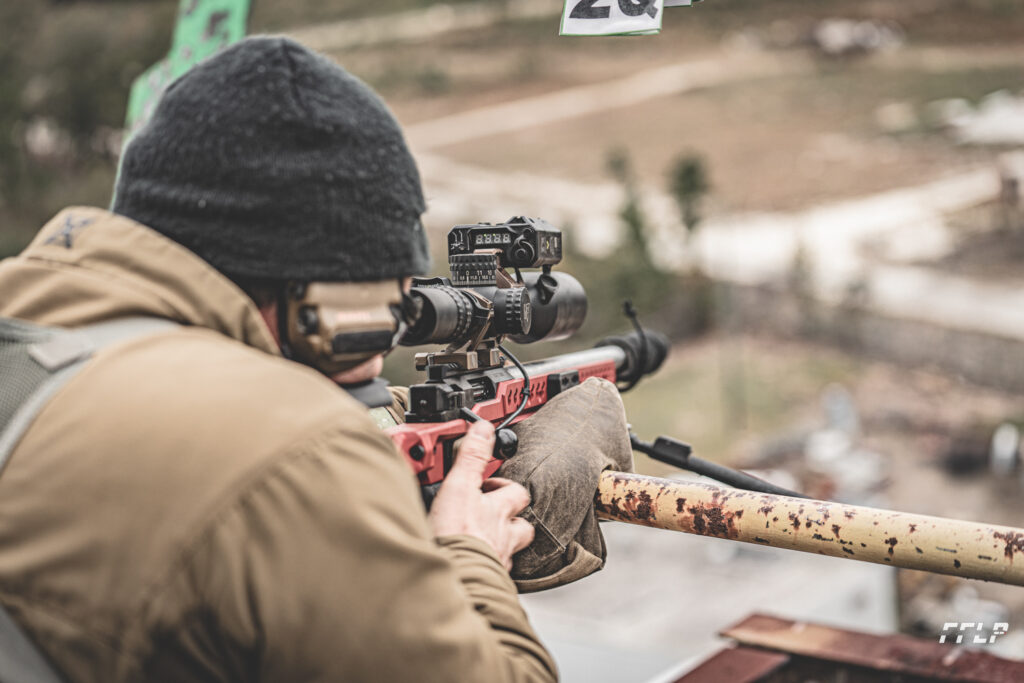
The first day ended with comparing notes and stage stories, before a BBQ dinner. Also during the evening was the raffle for prize table items (the more you spend the better your chances…) and the presentation of a $15,000 check to the Connie Maxwell Children’s Ministries. When I wrote earlier that the Guardian has a purpose, this is ultimately what it’s about… summed up with a well known Guardian phrase “it’s for the kids”.
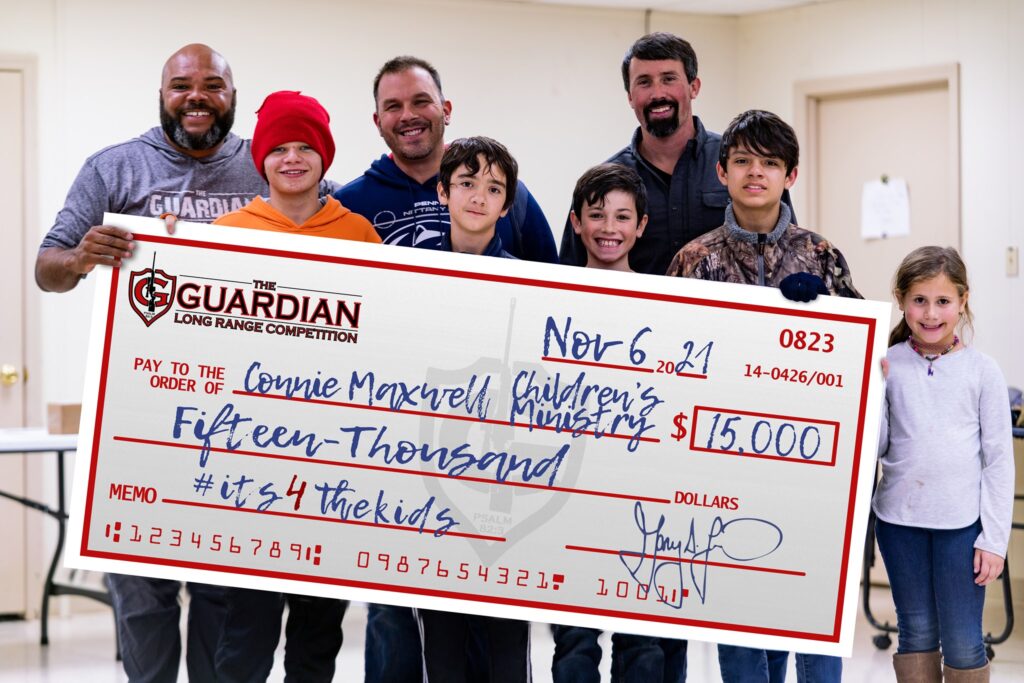
Day Two
The second day started earlier, only because the time changed overnight. We headed to our second set of stages to get the day going.
Stage 5 – Drive By Zombie
Drive By Zombie was the moving target stage. Each shooter assumed a firing position using the edge of the roof for support and fired six rounds out of their rifle, in the direction the mover was coming from (right shooter shoots right to left and vice versa). Then the shooters swapped rifles and directions, engaged for another six rounds. Finally, each shooter went to pistols for three steel plates located several stories down.
Having clone rifles on this stage paid off for us. No information was given on the mover, so we decided Greg would setup first while I ranged the target and got my Kestrel setup. In the Kestrel 5700 Elite, there is a moving target estimation tool where you input range, distance of movement via your reticle and then a time the distance is covered. I lased the target at 650 yards, and we agreed to a 2 Mil-Radian movement before the stage started. Then Greg called start/stop while I did ran the timer on the Kestrel. We did this several times, averaging about a 2.4-2.5 mph mover. For our guns this worked out to a 1.4-1.5 Mil lead to center with no wind. Greg engaged first and got his hits at 2 Mils of lead. I ended up needing far lead due to wind, hitting closer to about 1 Mil of lead…but it took me a couple shots to figure that out. The number of shots per pass was not limited, but we were comfortable with two shots per mover pass. After we swapped guns we each dropped a shot or two as well. Finally we ended the pistol shooting with Greg going 3/3 and I dropped my last pistol shot for 2/3. We tallied up 22 points, which ended up being a stage win.
Stage 6 – Rooftop Rampage
This stage was the only one that required a ladder to access compared to the extensive ladder work from before. At the top, shooters started with a nice 60 yard run across the rooftop to the firing position at the other side. There were four white IPSC plates to engage about 800 yards away. Shooters had to fire three rounds apiece, with both shooters engaging a target before picking another target. The IPSCs were located at the edge of a field, with brush/trees in the backdrop making any misses impossible to read. From the holding area we were measuring the wind bouncing between 6 and 12 miles per hour, with rapidly changing frequency…basically one of the more frustrating conditions to shoot in.
At the start we took off across the roof and I got into position first. We chose to use our Gamechangers on the edge of the roof, which worked well for positioning and stabilizing the rifle. I found the targets on binos and grabbed quick ranges, recording on my armboard. Greg was the lead off shooter, and we worked our way through the targets chasing the wind. Ultimately we hit 9 out of 24 shots, our lowest score on a stage. One team ran away on this one with a 16, but our nine was actually very good compared to an average of 2.5 points.
Stage 1 – Prairie Doggin’ It
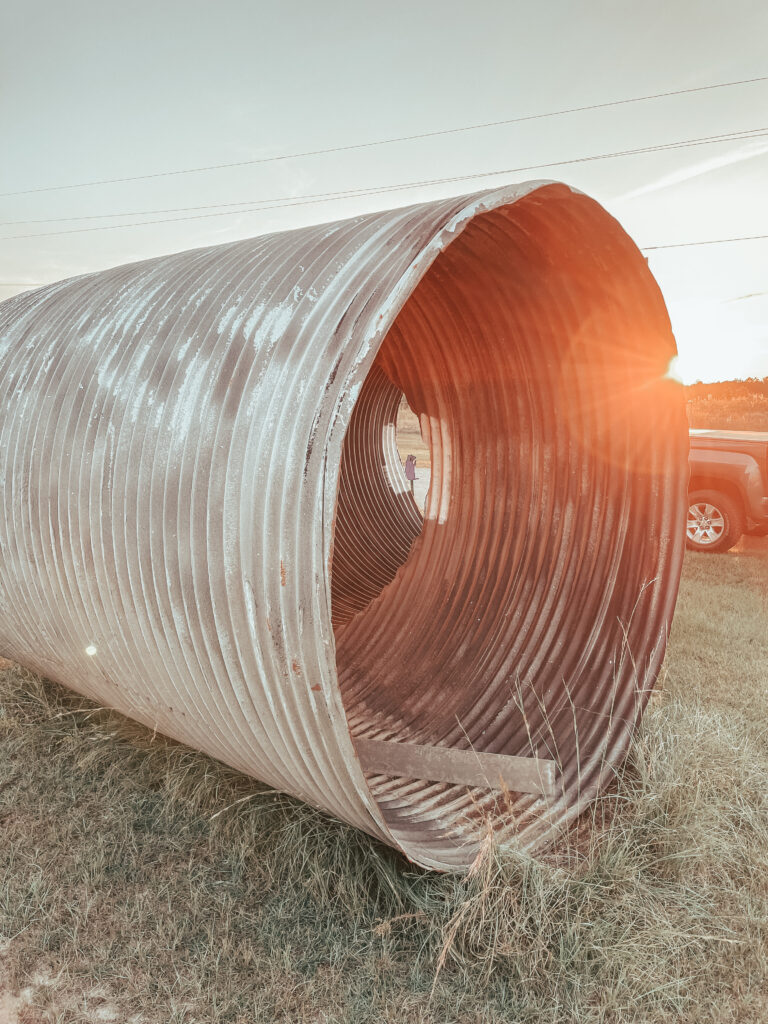
Prairie Doggin’ It was one of my favorite stages. It began with a run up stairs to the top of a building. From the top, three pistol plates had to be hit by each shooter before moving on. Then the teams ran to a plywood platform where all gear and teammates must be inside. There were four prairie dog targets hidden in the foreground that had to be located and engaged with three rounds a piece. As we got into rifle position I started looking too far to the right before Greg found the first target. He gave it a little too much of a wind hold, but then we worked our way through the targets from about 185 to 250 yards away. This was one that was easy to go too fast and miss, but we both made it a point to be deliberate and not waste any shots. With only dropping the one shot, we tied for the high score on this stage at 29 points.
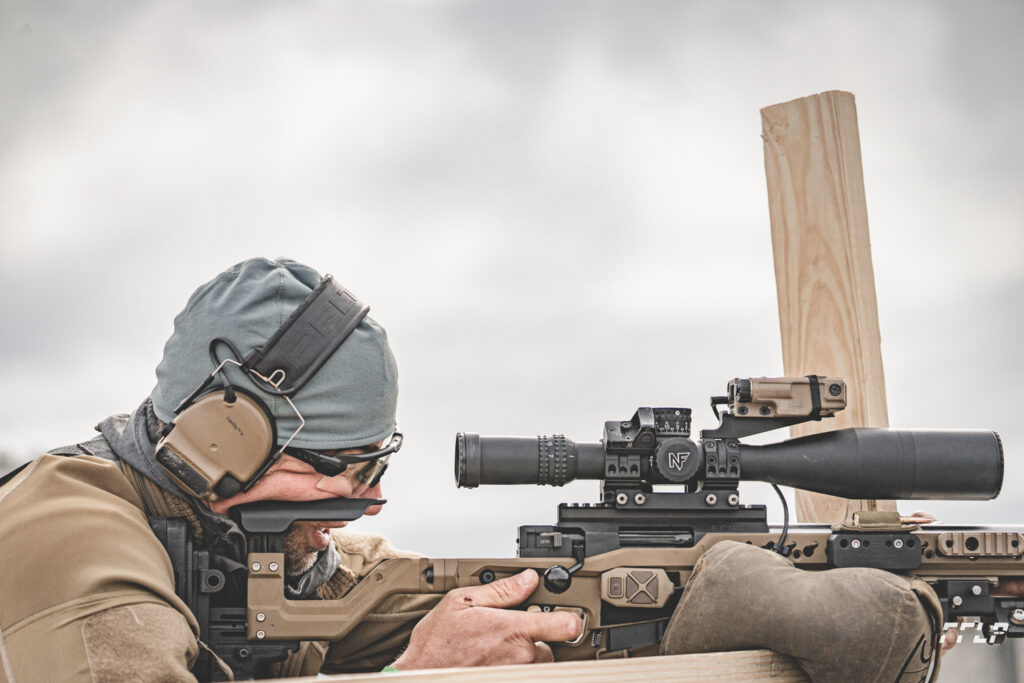
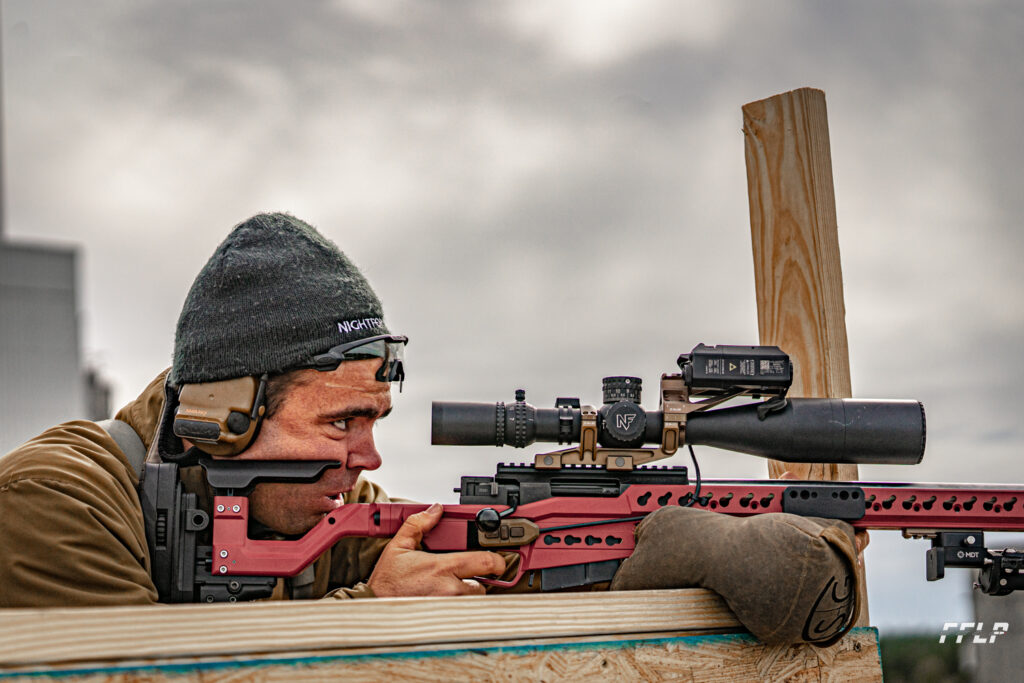
Stage 2 – Tight Squeeze
This was another of my favorites from the match. Rifles were staged on top of a mini roof-top, with shooters below. At the start, we ran to the edge of the main roof and had to find and engage three pistol plates located below. Once all three were hit, we ditched pistols and climbed stairs to our rifles. The rifle targets were to be engaged in order left, middle, right, middle, left, with each shooter firing two rounds a piece before shifting to the next target. These targets were about 625-650 yards away, and painted red with a white X. The wind was still blowing in the 6-12mph gusting variety, so we worked the wind a little but got a fair amount of hits, earning 20 points total on the stage.
Stage 3 – Mad Max
The Mad Max stage was probably the most controversial stage of the whole match, but it had lots of thrills. It started with both shooters engaging some drive-by pistol steel off the back of a flat-bed truck. At the end of the run, a spinner target had to be rolled to finish on some hostage taker targets.
Our pistol shooting on the truck bed looked cool, but we were disappointed with the low number of hits we got. When we got to the rifle portion, the spinner was an unlimited amount of rounds to attempt to get it over…and the word was it was a doozy. We strategized to do a command fired shot for our first round and rapidly follow up as we could. Fortunately for us our command fire on the bottom plate rolled the spinner, so we immediately went to work on the hostage targets. We only firing seven rounds a piece on the stage despite each having 30 sitting there ready to go…finishing with a score of 22, mainly due to misses with the pistol.
After the match, Gary apologized for incorrectly setting up the spinner, keeping all of the balancing weights on it. In total, only about a third of the teams got the spinner over. We got to watch several teams after our run, and the spinner needed two simultaneous hits or very rapid 1-2 shots on the plates because it bled speed off very fast due to the weights. We heard some teams fired over 50 rounds trying to roll the spinner, and the concrete barrier behind it was chewed all the way through! Aside from the weights, there was some wind and timing is everything on a fast spinner.
Pro-Tip on spinners: you need to fire in anticipation of where the plate is going to be… so well before the plate gets to where you want to hit it. We saw a fair amount of shooting firing too late and missing the plate due to timing.
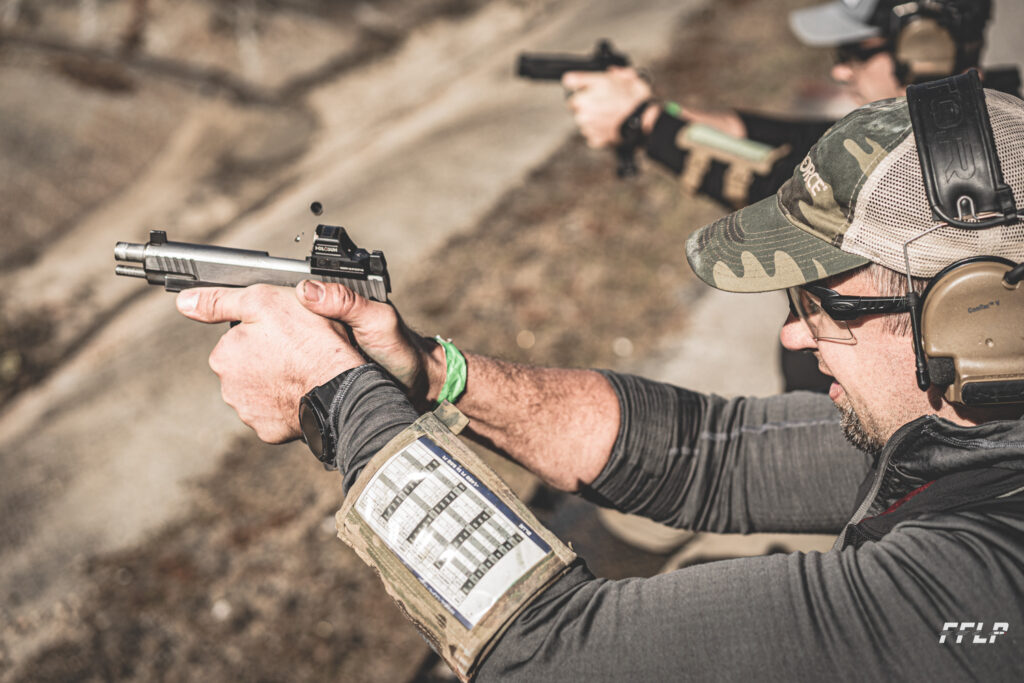
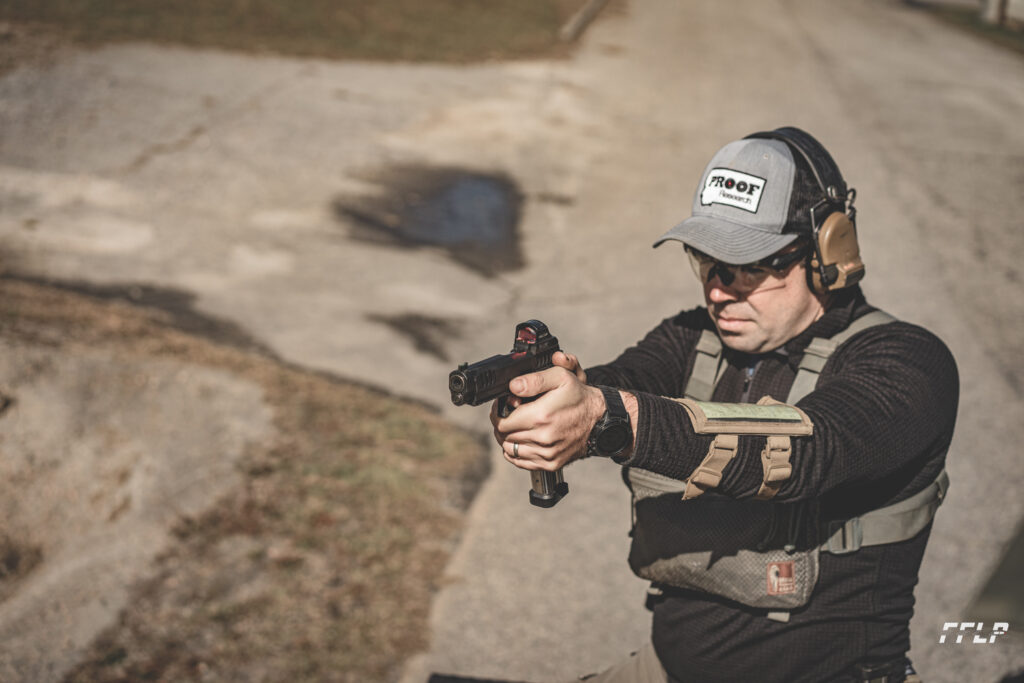
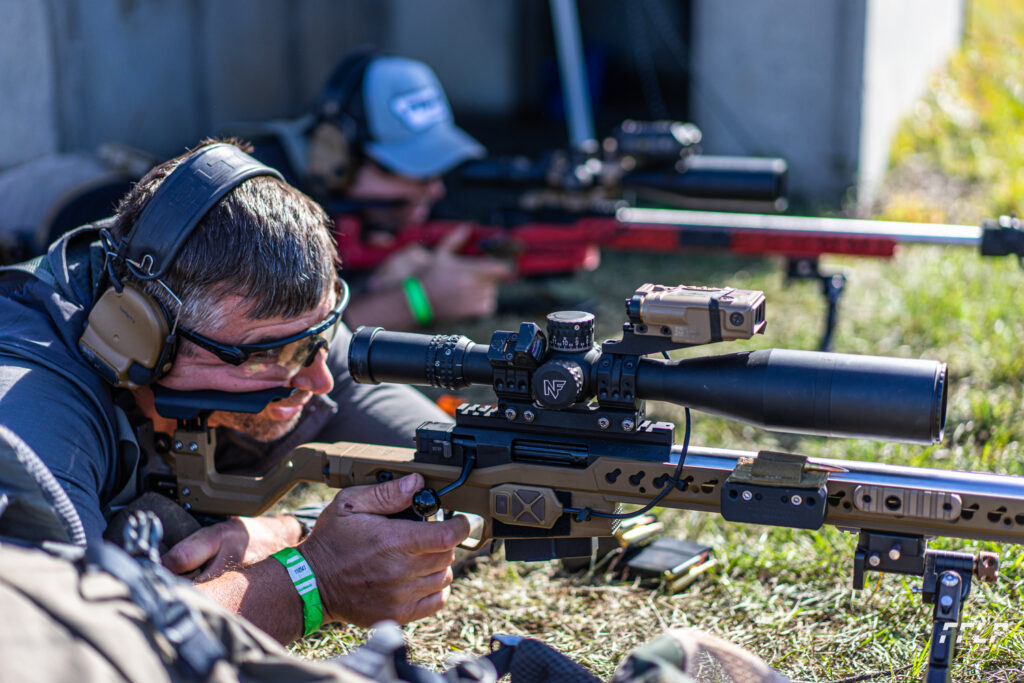
Stage 4 – Duck, Duck, Goose
Our last stage of the match was Duck, Duck, Goose. The start position was on top of some stacked shipping containers, with guns ready to go. First, a “piano key” target, what we also call a ruler had to be found. It is a very thin but tall target…made infamous at the Mammoth Sniper Challenge. Each shooter had to hit it before anything else could be done on the stage. Once hit, there were two duck targets and a final target that had to be hit, with the bullet passing through a cut out torso target. The first shooter hit these left to right, followed by the second shooter…then both did it again in reverse.
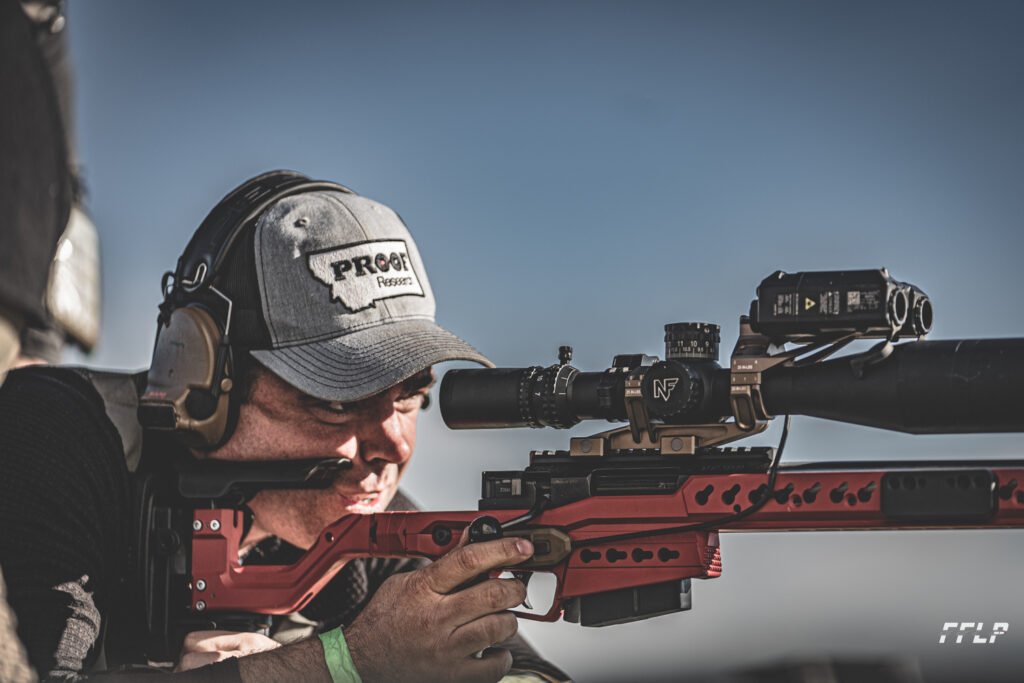
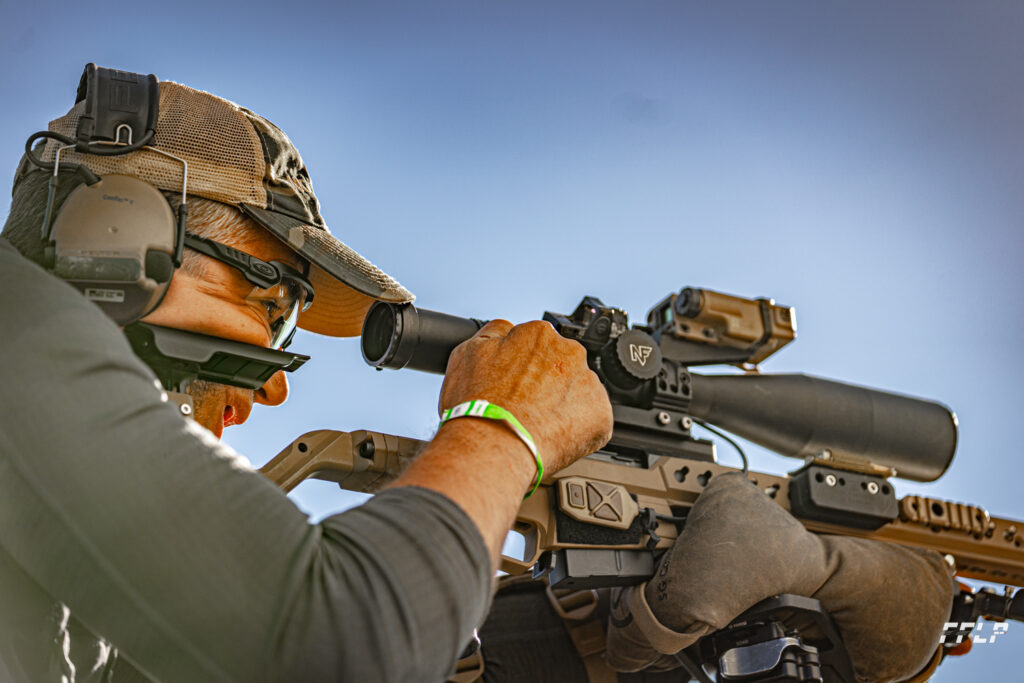
We got on the ruler and hit it pretty quickly, but then the rest took a little longer to find. The ducks were pretty well shot up and grayed out, also hidden with a lowering sun and mirage. Greg got on target and fired twice, but it ended up being target two…so he just re-engaged for his target two shots. The last target was in a location that required getting on a tripod or getting on the very back, left corner of the container. I tried to get him into the prone position but that didn’t work out, so instead of continuously burning time I had him engage two into the target area and move to setup his tripod. I jumped down and ended up half hanging off the back of the container to get my first run. He then ran his tripod on the hard target, then went prone again for the other two. At this point I had about 15 seconds for the three targets…so I let the AI eat and worked the bolt hard getting five shots off on three targets, with a sixth fired slightly past time expiring. However, four of the five were hits… making our final score 14 for the stage.
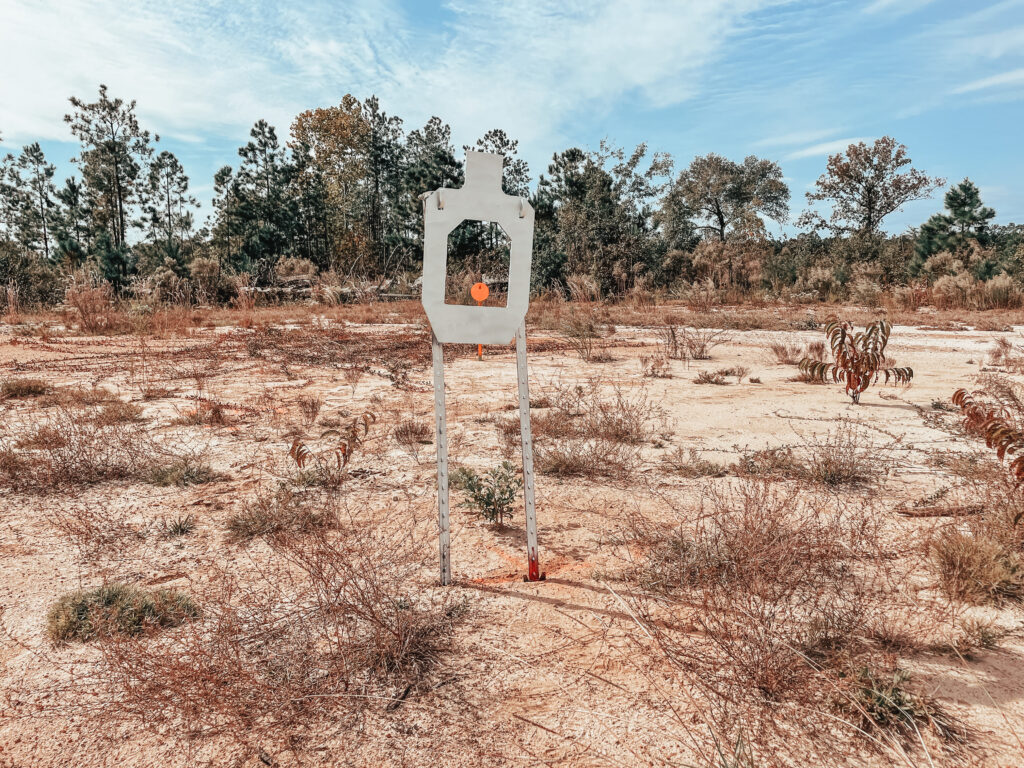
Summary
In total, we shot a 259 out of a possible 350 points for a first place finish. We came into the match a little rusty, not having shot together since April, but we got things sorted out pretty quickly. The six minute stages were nice as you had enough time to get a lot of shooting in. Overall the match tested a variety of skills that a precision rifle shooter should be able to handle. Nothing was impossible, the weather threw some curveballs via frustrating winds, but otherwise if you can get to a Guardian match you’ll be in for a good time.
A few notes otherwise:
- We gambled with putting together a rifle at the last minute, but it worked out for us. The AT-Xs ran very well, and having identical guns paid off on a couple stages. Essentially the AT-X combined an AI action with a chassis design in-line with modern competitive rifles. Shooting them off of heavy Gamechangers was a joy to do for the positional stuff.
- The weapon mounted LRFs are nice but not essential. GTI has a lot of railings, and of all the places we shoot we use them the most…but a good pair of LRF equipped binos are the real finding and ranging workhorses for us.
- Pistols equal points, a lesson we emphasize in the team classes we teach. There were 24 shots required for pistol at the match, but a lot of them were limited round count in that it was a hit or miss proposition instead of keep firing until you hit. In looking at the scores, only 1-2 points separated a lot of placements.
- Communication is always key in a team environment. Even if each person is working with the best of intentions, some coordination is needed to ensure the efforts aren’t wasted.
- Shooting matches is still fun…as it should be.
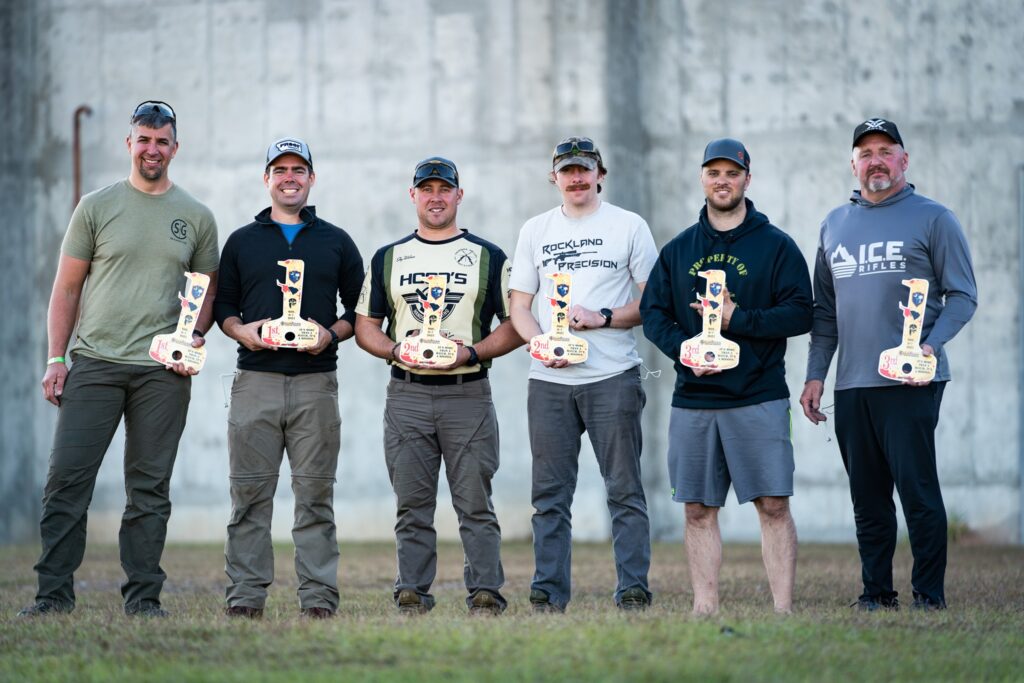
Here are the score for the match:

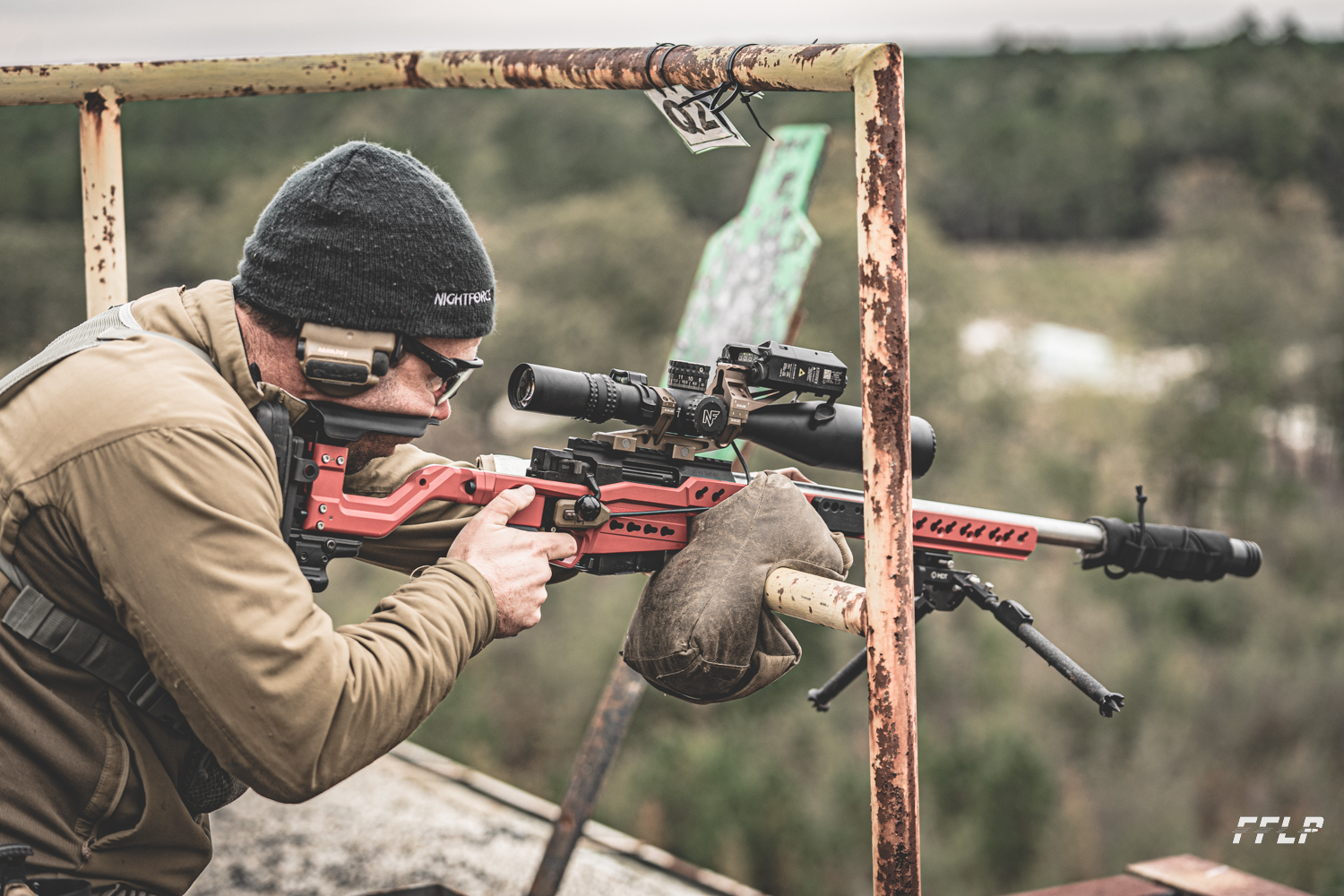
What a phenomenal AAR. Can I hire you to write our Stage Briefs?!? We also need to get more shooters to leverage your training classes! Hope y’all can make a match this year. -Gary Larson